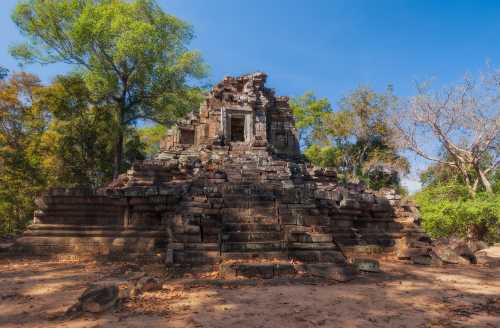App
Customer Support
Find Bookings
Popular Trip Moments
Majestic Angkor Wat | 🌿✨ *Srah Srang Tbong Village: Cambodia’s Hidden Silk-Weaving Sanctuary* 🧵🐛 | 🔥 "Echoes of Conflict: A Solo Journey Through Siem Reap’s War Museum" 💣 | 🌿 Hidden Gem Alert: Solo Trip to Banteay Kdei! 🏛️** | 🌅 Sunset Majesty: Solo Trip to Phnom Bakheng! 🏛️ | 🌿 The Enchanted Ruins: Solo Trip to Preah Khan Temple! 🏛️ | 🌿 The Smiling Stones: Solo Trip to Bayon Temple, Angkor Thom! 🗿 | 🌿 Ancient Wonders & Solo Adventures: Angkor Wat, Cambodia! 🏛️ | The Sacred Summit: Ascending to Angkor Wat's Second Floor Sanctuary | Thommanon Temple: Architectural Splendor of the Angkor Era Introduction: A Timeless Marvel | Angkor Wat Bas-relifes: Where Stone Whispers Devotion | TA NEI Temple: Angkor’s Wild Soul | Beyond the Tourist Trail: Discovering Krol Ko’s Whispering Ruins | Ta Keo Exploration: A Tale in The Stone | Time-Struck Sanctuaries: Unraveling Preah Pithu’s Ancient Secrets | Learning about its role during the Khmer Empire👫👍🥰 | Cambodia: Where Time Stands Still Between Temple Ruins and Turquoise Waters | The Terraces of Angkor Thom: A Voyage Through Ancient Grandeur | 【Cambodia】Ta Prohm Temple wrapped in tree roots. | Khmer Empire Ancient Royal Road Exploration Travel Guide | Climbing Through Time: The Ancient Secrets of Pre Rup Temple | Neak Pean: The Healing Waters of Angkor | The Gem of Siem Reap—Amansara Resort | A Temple Lover's Dream: The Perfect Angkor Outer Loop Itinerary | Hindu Gods, Buddhist Peace: The Dual Soul of Baphuon | The Pyramid Temples of Cambodia: Stairways to the Divine | Where Gods & Engineers Met: The Legacy of East Mebon | Bayon Temple: The Enigmatic Smile of Angkor Thom | Temples & Treetops: The Ultimate Siem Reap Jungle Expedition | Amazing Angkor Wat
Recommended Attractions at Popular Destinations
Popular Attractions in Bangkok | Popular Attractions in Manila | Popular Attractions in Tokyo | Popular Attractions in Taipei | Popular Attractions in Hong Kong | Popular Attractions in Seoul | Popular Attractions in Kuala Lumpur | Popular Attractions in Los Angeles | Popular Attractions in Shanghai | Popular Attractions in New York | Popular Attractions in Shenzhen | Popular Attractions in Osaka | Popular Attractions in Singapore | Popular Attractions in London | Popular Attractions in Guangzhou | Popular Attractions in San Francisco | Popular Attractions in Beijing | Popular Attractions in Macau | Popular Attractions in Bali | Popular Attractions in Jakarta | Popular Attractions in Paris | Popular Attractions in Ho Chi Minh City | Popular Attractions in Istanbul | Popular Attractions in Phuket | Popular Attractions in Chicago | Popular Attractions in Seattle | Popular Attractions in Toronto | Popular Attractions in Orlando | Popular Attractions in Cebu | Popular Attractions in Chiang Mai
Popular Restaurants in Siem Reap
Amok Restaurant | Mahob Khmer Cuisine | Chanrey Tree Restaurant | Hard Rock Cafe | Haven | Old House Restaurant | My Little Cafe | Original Khmer BBQ | Arun Restaurant | Cambodian BBQ Restaurant | Tonle Mekong Restaurant | Khmer Touch Cuisine | Belmiro's Pizza & Subs | Embassy Restaurant | Jungle Burger Sports Bar & Bistro | Kroya | Yellow Mango Cafe | The Square 24 Restaurant | Celadon Restaurant | Slek Morn Restaurant | Fresh Fruit Factory | Malis Restaurant Siem Reap | Banlle restaurant | Cuisine Wat Damnak - Siem Reap | The Sugar Palm | The Dining Room at Park Hyatt Siem Reap | The Red Piano - Pub Street | Common Grounds Cafe | Por Cuisine | The Sun
Popular Ranked Lists
Popular Trending Attractions in Dunhuang | Top 50 Luxury Hotels near Woodstock | Top 50 Must-Visit Restaurants in Vienna | Top 50 Must-Visit Restaurants in Florence | Top 10 Must-Visit Restaurants in Bad Ischl | Top 50 Must-Visit Restaurants in Bali | Top 50 Luxury Hotels near Mannheim | Popular Premium Hotels in Astrakhan | Top 50 Must-Visit Restaurants in London | Top 50 Must-Visit Restaurants in Athens | Popular Premium Hotels in Pasadena | Top 10 Trending Attractions in Wuhan | Top 10 Trending Attractions in Tokyo | Top 10 Local Restaurants in Lushan Global Geopark | Top 20 Trending Attractions in Beijing | Popular Premium Hotels in Sioux City | Top 50 Must-Visit Restaurants in San Francisco | Top 50 Must-Visit Restaurants in Hanoi | Top 50 Must-Visit Restaurants in Frankfurt | Top 50 Must-Visit Restaurants in Tokyo | Top 50 Must-Visit Restaurants in Melbourne | Popular Premium Hotels in Warnemunde | Top 20 Luxury Hotels near Oakland | Top 50 Must-Visit Restaurants in Suzhou | Popular Premium Hotels in Iowa | Popular Premium Hotels in Rohero | Top 50 Must-Visit Restaurants in Singapore | Popular Trending Attractions in Changzhou | Popular Trending Attractions in London | Popular Trending Attractions in Quanzhou
About
Payment Methods
Our Partners
Copyright © 2025 Trip.com Travel Singapore Pte. Ltd. All rights reserved
Site Operator: Trip.com Travel Singapore Pte. Ltd.
Site Operator: Trip.com Travel Singapore Pte. Ltd.














